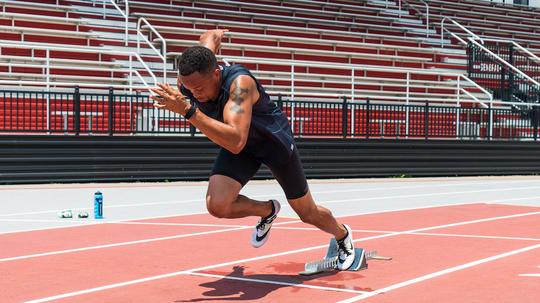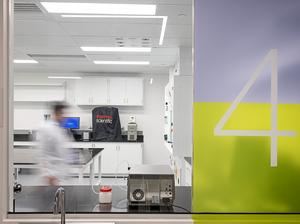
It was the beginning of summer, but the water felt ice cold as Ramses Alcaide submerged his body into the lake and swam under two floating barrels. When he emerged from the other side, he sensed something important missing.
Under normal circumstances, Alcaide wouldn't opt to shove his body back into freezing water, but the WHOOP — a $500 wearable device that measures body strain and is made by a Boston startup of the same name — was important enough that he spent a good 10 minutes looking under and around the floating barrels to find his prized possession.
"That's how much I wanted it back," recalls Alcaide, CEO and co-founder of Neurable, a Boston-based startup that shares a common investor with WHOOP.
Alcaide isn't the first person to have a story like this, where WHOOP user feels a sense of alarm as soon as they are separated from the device. Anecdotes like these help illustrate why WHOOP, a finalist for this year's 50 on Fire, has been able to build a sense of loyalty among its users, attract star athletes like LeBron James and Michael Phelps and land agreements with Major League Baseball and the NFL Players Association. WHOOP keeps its sales numbers a secret, but the company said its wearable is used by pro athletes across all major North American sports leagues — including the National Hockey League, Major League Soccer and Women's National Basketball League — as well as by Olympians and CrossFit teams.
As more established wearable companies like Fitbit experience waning popularity, WHOOP's focus on established and aspiring athletes looking to improve their performance could put the wearable company in a league of its own.
Alcaide said he had received his WHOOP as a gift from Sarah Downey, a principal at the Cambridge venture capital firm Accomplice that has invested in both WHOOP and Alcaide's company, Neurable. He said he had been training for the Boston Marathon, so WHOOP made a great way for him to train ahead of the race.
With a strap that fits around your wrist, the WHOOP is able to measure body strain before and after workouts, how fast it takes for your body to recover and how much you sleep every night. Using that data, WHOOP provides suggestions through an analytics dashboard on how to find a balance between pushing your body's limits during workouts and avoiding overtraining or injury. Suggestions can include when to sleep more, drink less or take a break from more intense workouts for a day or two.

"The best part about it is it gave me the motivation to take more sleep," Alcaide said of his training for the Boston Marathon.
Alcaide said what he also liked about WHOOP is that the wearable would give him a strain score, which helped him understand how much he could push his body during workouts before he overexerted himself. "As someone who doesn't have a coach, having that information was very empowering," he said.
Up until last fall, the WHOOP was only available to pro athletes, who helped the company validate its ability to measure and optimize physical performance.
Will Ahmed, the company's CEO and founder, said there have been a number of ways the company has been able to measure its success with the wearable. For instance, he said, athletes have been able to recover faster from injuries with the WHOOP. The company has also found that Olympians can complete faster time trials.
"Professional athletes wouldn't wear something continuously unless it gives them really meaningful data."
On WHOOP's website, the company said athletes using the wearable after four months reduce injuries by 60 percent and decrease resting heart rate by 4.4 beats per minute. These athletes also increased the amount of nightly sleep and decreased alcohol consumption by 79 percent.
"Professional athletes wouldn't wear something continuously unless it gives them really meaningful data," Ahmed, a Harvard University graduate, said. "That’s what differentiates WHOOP from other companies on the market."
While the company is looking to expand its reach by selling the WHOOP to consumers, the company is still aiming to make a bigger splash with pro athletes. Two of its most significant announcements came this year when the company landed a deal with the NFL Players' Association in April and became the first wearable of its kind in March to be approved for in-game use by Major League Baseball.
As part of its exclusive five-year deal with the NFLPA, the company is providing its wearable to every current and incoming NFL player. The players will also have the option to sell their strain and recovery data, which could be used, for example, to provide additional statistics during broadcasts or in fantasy sports apps. The company is also working with the NFLPA to study the impact of travel, sleep, scheduling and injuries on each player's ability to recover.
"This is the first time ever that a players association has partnered with a tech company," Ahmed said. This marked another first: professional athletes agreeing to sell their health data, which Ahmed said could be used by healthcare providers.
When WHOOP became approved for in-game use by the MLB, it was a big deal for the company: up until then, no sports league had given its players explicit approval to use a wearable device during a match. That fact was highlighted last year when the NBA caught Cleveland Cavaliers point guard Matthew Dellavedova wearing a WHOOP while the league had a ban on all wearables. With the MLB's approval of the WHOOP, it could pave the way for more leagues to allow in-game use of the wearable.
"I have to compliment MLB on the steps that they took to understand the WHOOP technology,” Ahmed wrote in a blog post at the time. "From a process standpoint: They listened to their teams that were interested in buying the product, they listened to us as we explained our technology, they commissioned a study to better understand the technology, they gathered feedback from their athletes and teams upon using WHOOP, they examined the findings of the study carefully, and they followed a thorough review process for approving WHOOP in games which included safety testing. I think there’s a lot to learn from this process in general."
Ahmed said the company plans to expand within the pro athlete market, as well as collegiate teams (the company announced a deal with Duke University's men's basketball team in September). But he thinks there is a big opportunity with consumers as well.
"I think it’s a really compelling product offering for any athlete," he said.








